QUESTION 1 The chisquare distribution is useful for testing
QUESTION 1
The chi-square distribution is useful for testing
a sample variance
a sample mean
a population mean
a population variance
0.67 points
QUESTION 2
The F distribution is useful for testing
difference between two sample means
a single popuation variance
the ratio of two population means
the ratio of two population variances
0.67 points
QUESTION 3
The manager of the service department of a local car dealership has found that the service times of a sample of 15 new automobiles has a standard deviation of 3 minutes.
If a 95% confidence interval for the variance of service times for all their new automobiles extends from A to B (A < B), then the value of A is
6.381
3.751
4.824
9.796
0.67 points
QUESTION 4
The manager of the service department of a local car dealership has found that the service times of a sample of 15 new automobiles has a standard deviation of 3 minutes.
If a 95% confidence interval for the variance of service times for all their new automobiles extends from A to B (A < B), then the value of B is
39.796
16.381
22.384
34.751
0.67 points
QUESTION 5
Ten years ago the standard deviation of the ages of the UT undergraduate business students was 1.5 years. Recently a sample of 26 such students had a standard deviation of 2.0 years. We are interested to see if there has been an increase in the standard deviation of the ages of the UT undergraduate business students.
The null hypothesis is
H0: 2 < 2.25
H0: 2 2.25
H0: 2 2.25
H0: 2 > 2.25
0.67 points
QUESTION 6
Ten years ago the standard deviation of the ages of the UT undergraduate business students was 1.5 years. Recently a sample of 26 such students had a standard deviation of 2.0 years. We are interested to see if there has been an increase in the standard deviation of the ages of the UT undergraduate business students.
The alternative hypothesis is
H0: 2 2.25
H0: 2 < 2.25
H0: 2 > 2.25
H0: 2 > 10
0.66 points
QUESTION 7
Ten years ago the standard deviation of the ages of the UT undergraduate business students was 1.5 years. Recently a sample of 26 such students had a standard deviation of 2.0 years. We are interested to see if there has been an increase in the standard deviation of the ages of the UT undergraduate business students.
The value of the test statistic is
35.21
28.64
22.22
44.44
0.66 points
QUESTION 8
Ten years ago the standard deviation of the ages of the UT undergraduate business students was 1.5 years. Recently a sample of 26 such students had a standard deviation of 2.0 years. We are interested to see if there has been an increase in the standard deviation of the ages of the UT undergraduate business students.
The p-value of the test is
less than 0.005
more than 0.025
between 0.01 and 0.005
between 0.025 and 0.01
0.66 points
QUESTION 9
Ten years ago the standard deviation of the ages of the UT undergraduate business students was 1.5 years. Recently a sample of 26 such students had a standard deviation of 2.0 years. We are interested to see if there has been an increase in the standard deviation of the ages of the UT undergraduate business students.
Assuming 1% significance level, what is your conclusion?
There has been no increase in the standard deviation of the ages of the UT undergraduatebusiness students.
There has been a decrease in the standard deviation of the ages of the UT undergraduate business students.
There has been no change in the standard deviation of the ages of the UT undergraduatebusiness students.
There has been an increase in the standard deviation of the ages of the UT undergraduate business students.
0.66 points
QUESTION 10
We are interested in determining whether or not the variances of the daily sales at two small grocery stores are equal. A sample of 16 days of sales at Store 1 yields a sample variance of 600, and a sample of 16 days of sales at Store 2 yields a sample variance of 300.
The null hypothesis is:
H0: the two population variances are equal
H0: the two sample variances are equal
H0: the two sample variances are not equal
H0: the two population variances are not equal
0.67 points
QUESTION 11
We are interested in determining whether or not the variances of the daily sales at two small grocery stores are equal. A sample of 16 days of sales at Store 1 yields a sample variance of 600, and a sample of 16 days of sales at Store 2 yields a sample variance of 300.
The value of the test statistic is
1.96
2.00
1.00
1.41
0.66 points
QUESTION 12
We are interested in determining whether or not the variances of the daily sales at two small grocery stores are equal. A sample of 16 days of sales at Store 1 yields a sample variance of 600, and a sample of 16 days of sales at Store 2 yields a sample variance of 300.
The p-value of the test is
less than 0.05
more than 0.20
between 0.10 and 0.20
between 0.05 and 0.10
0.66 points
QUESTION 13
We are interested in determining whether or not the variances of the daily sales at two small grocery stores are equal. A sample of 16 days of sales at Store 1 yields a sample variance of 600, and a sample of 16 days of sales at Store 2 yields a sample variance of 300.
At 10% significant level, the critical F value (under the upper tail) is
2.40
1.96
1.92
2.95
0.66 points
QUESTION 14
We are interested in determining whether or not the variances of the daily sales at two small grocery stores are equal. A sample of 16 days of sales at Store 1 yields a sample variance of 600, and a sample of 16 days of sales at Store 2 yields a sample variance of 300.
At 10% significant level one can conclude that
the population variances of the sales of the two small grocery stores are different
the population variances of the sales of the two small grocery stores can be the same
the sample variances of the sales of the two small grocery stores can be the same
the sample variances of the sales of the two small grocery stores are not comparable
0.66 points
QUESTION 15
The most recent census data indicated that 70 percent of a city community was Caucasian, 20 percent Black, and 10 percent Hispanic. A random sample of 200 employees of a large firm in this city revealed that 160 were Caucasian, 30 were Black, and 10 were Hispanic. At the 1 percent significance level can we conclude that the distribution of the firm employees does not reflect the general population?
The null hypothesis is
H0: pC 0.80 or pB 0.15 or pH 0.05
H0: pC 0.70 or pB 0.20 or pH 0.10
H0: pC = 0.80, pB = 0.15, pH = 0.05
H0: pC = 0.70, pB = 0.20, pH = 0.10
0.67 points
QUESTION 16
The most recent census data indicated that 70 percent of a city community was Caucasian, 20 percent Black, and 10 percent Hispanic. A random sample of 200 employees of a large firm in this city revealed that 160 were Caucasian, 30 were Black, and 10 were Hispanic. At the 1 percent significance level can we conclude that the distribution of the firm employees does not reflect the general population?
The expected frequency for the Black category is
60
50
40
30
0.67 points
QUESTION 17
The most recent census data indicated that 70 percent of a city community was Caucasian, 20 percent Black, and 10 percent Hispanic. A random sample of 200 employees of a large firm in this city revealed that 160 were Caucasian, 30 were Black, and 10 were Hispanic. At the 1 percent significance level can we conclude that the distribution of the firm employees does not reflect the general population?
The value of the test statistic is
5.432
13.192
10.357
8.715
0.67 points
QUESTION 18
The most recent census data indicated that 70 percent of a city community was Caucasian, 20 percent Black, and 10 percent Hispanic. A random sample of 200 employees of a large firm in this city revealed that 160 were Caucasian, 30 were Black, and 10 were Hispanic. At the 1 percent significance level can we conclude that the distribution of the firm employees does not reflect the general population?
At 1% significance level, the null hypothesis can be rejected if the value of the test statistic is
< 11.345
6.635
9.210
11.345
0.67 points
QUESTION 19
The most recent recent census data indicated that 70 percent of a city community was Caucasian, 20 percent Black, and 10 percent Hispanic. A random sample of 200 employees of a large firm in this city revealed that 160 were Caucasian, 30 were Black, and 10 were Hispanic. At the 1 percent significance level can we conclude that the distribution of the firm employees does not reflect the general population?
At 1% significance level, one can conclude that
There is insufficient information to make any conclusion
The distribution of the firm employees reflects the city community
The firm cannot be accused of engaging in prejudicial hiring practices
The firm can be accused of engaging in prejudicial hiring practices.
0.67 points
QUESTION 20
The results of a recent study regarding heavy alcohol drinking and getting a liver disease are shown in the following table.
Non-Drinkers
Drinkers
Totals
Liver disease
68
82
150
No liver disease
32
18
50
Totals
100
100
200
We are interested in determining whether or not getting a liver disease is independent of heavy drinking.
The expected frequency for the cell (No liver disease, Drinkers) is
75
25
18
82
0.67 points
QUESTION 21
The results of a recent study regarding heavy alcohol drinking and getting a liver disease are shown in the following table.
Non-Drinkers
Drinkers
Totals
Liver disease
68
82
150
No liver disease
32
18
50
Totals
100
100
200
We are interested in determining whether or not getting a liver disease is independent of heavy drinking.
The value of the test statistic is
10.516
1.307
5.227
3.062
0.67 points
QUESTION 22
The results of a recent study regarding heavy alcohol drinking and getting a liver disease are shown in the following table.
Non-Drinkers
Drinkers
Totals
Liver disease
68
82
150
No liver disease
32
18
50
Totals
100
100
200
We are interested in determining whether or not getting a liver disease is independent of heavy drinking.
The p-value of the test is
between 0.025 and 0.01
more than 0.05
between 0.05 and 0.025
less than 0.01
0.66 points
QUESTION 23
The results of a recent study regarding heavy alcohol drinking and getting a liver disease are shown in the following table.
Non-Drinkers
Drinkers
Totals
Liver disease
68
82
150
No liver disease
32
18
50
Totals
100
100
200
We are interested in determining whether or not getting a liver disease is independent of heavy drinking.
At 5% significance level, the null hypothesis is rejected if the value of the chi-square test statistic is
6.635
3.841
5.024
5.991
0.66 points
QUESTION 24
The results of a recent study regarding heavy alcohol drinking and getting a liver disease are shown in the following table.
Non-Drinkers
Drinkers
Totals
Liver disease
68
82
150
No liver disease
32
18
50
Totals
100
100
200
We are interested in determining whether or not getting a liver disease is independent of heavy drinking.
At 5% significance level, one can conclude that
Getting a liver disease is independent of heavy drinking
There is insufficient evidence to make any conclusion
Getting a liver disease is not independent of heavy drinking
Getting a liver disease causes heavy drinking
0.67 points
QUESTION 25
Sara Lee recently developed a new cheesecake. The regional manager for Sara Lee would like to know if there is a difference in the mean number of cakes sold daily at Meijer stores in Sylvania, Northwood, and Maumee; denote these means by µ1, µ2 and µ3, respectively. She selects a sample of days from each of the stores and finds the number of cakes sold on that day. The results are as follows:
The single factor Anova test was conducted at 5% significance level, and the following incomplete Anova table is available:
What is the null hypothesis ?
none of these
H0: µ1 = µ2 = µ3
H0: µ1 µ2 µ3
H0: µ1 µ2 or µ1 µ3 or µ2 µ3
0.67 points
QUESTION 26
Sara Lee recently developed a new cheesecake. The regional manager for Sara Lee would like to know if there is a difference in the mean number of cakes sold daily at Meijer stores in Sylvania, Northwood, and Maumee; denote these means by µ1, µ2 and µ3, respectively. She selects a sample of days from each of the stores and finds the number of cakes sold on that day. The results are as follows:
The single factor Anova test was conducted at 5% significance level, and the following incomplete Anova table is available:
What is the alternative hypothesis ?
Ha: µ1 µ2 or µ1 µ3 or µ2 µ3
Ha: µ1 = µ2 = µ3
H0: µ1 µ2 µ3
none of these
0.67 points
QUESTION 27
Sara Lee recently developed a new cheesecake. The regional manager for Sara Lee would like to know if there is a difference in the mean number of cakes sold daily at Meijer stores in Sylvania, Northwood, and Maumee; denote these means by µ1, µ2 and µ3, respectively. She selects a sample of days from each of the stores and finds the number of cakes sold on that day. The results are as follows:
The single factor Anova test was conducted at 5% significance level, and the following incomplete Anova table is available:
What is the value of the test statistic hypothesis ?
1.96
alpha = 0.05
4.1
39.1
0.67 points
QUESTION 28
Sara Lee recently developed a new cheesecake. The regional manager for Sara Lee would like to know if there is a difference in the mean number of cakes sold daily at Meijer stores in Sylvania, Northwood, and Maumee; denote these means by µ1, µ2 and µ3, respectively. She selects a sample of days from each of the stores and finds the number of cakes sold on that day. The results are as follows:
The single factor Anova test was conducted at 5% significance level, and the following incomplete Anova table is available:
What is the p-value of the test?
less than 0.01
more than 0.05
between 0.025 and 0.05
between 0.01 and 0.025
0.67 points
QUESTION 29
Sara Lee recently developed a new cheesecake. The regional manager for Sara Lee would like to know if there is a difference in the mean number of cakes sold daily at Meijer stores in Sylvania, Northwood, and Maumee; denote these means by µ1, µ2 and µ3, respectively. She selects a sample of days from each of the stores and finds the number of cakes sold on that day. The results are as follows:
The single factor Anova test was conducted at 5% significance level, and the following incomplete Anova table is available:
Using the critical value approach, the null hypothesis is rejected if the value of the F test stattistic satisfies:
F 39.10
F 4.10
F alpha = 0.05
F 1.96
0.67 points
QUESTION 30
Sara Lee recently developed a new cheesecake. The regional manager for Sara Lee would like to know if there is a difference in the mean number of cakes sold daily at Meijer stores in Sylvania, Northwood, and Maumee; denote these means by µ1, µ2 and µ3, respectively. She selects a sample of days from each of the stores and finds the number of cakes sold on that day. The results are as follows:
The single factor Anova test was conducted at 5% significance level, and the following incomplete Anova table is available:
What is your conclusion?
The mean number of cakes sold daily in the three stores can be the same.
The mean number of cakes sold daily in the three stores are not the same.
The number of cakes sold daily in the three stores can be the same.
The number of cakes sold daily in the three stores are not the same.
| a sample variance | ||
| a sample mean | ||
| a population mean | ||
| a population variance |
Solution
CHEGG\'S POLICY ALLOW ME TO ANSWER 1 QUESTION PER POST
I CAN GLADLY HELP YOU WITH ALL YOUR QUESTION BUT YOU SHOULD POST IT IN A NEW QUESTION
QUESTION 1
The chi-square distribution is useful for testing
a population variance
0.67 points
QUESTION 2
The F distribution is useful for testing
the ratio of two population variances
| a population variance |
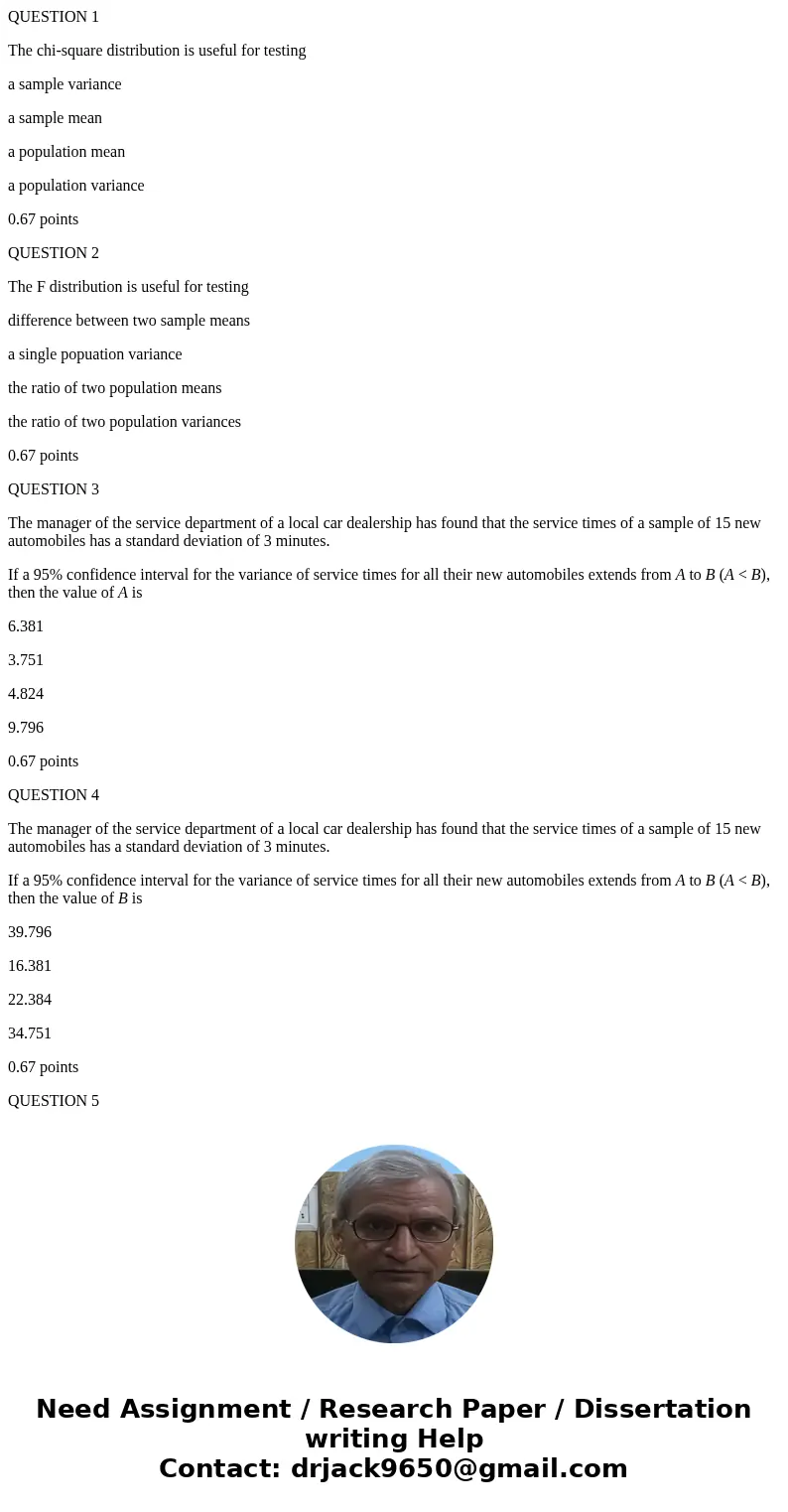
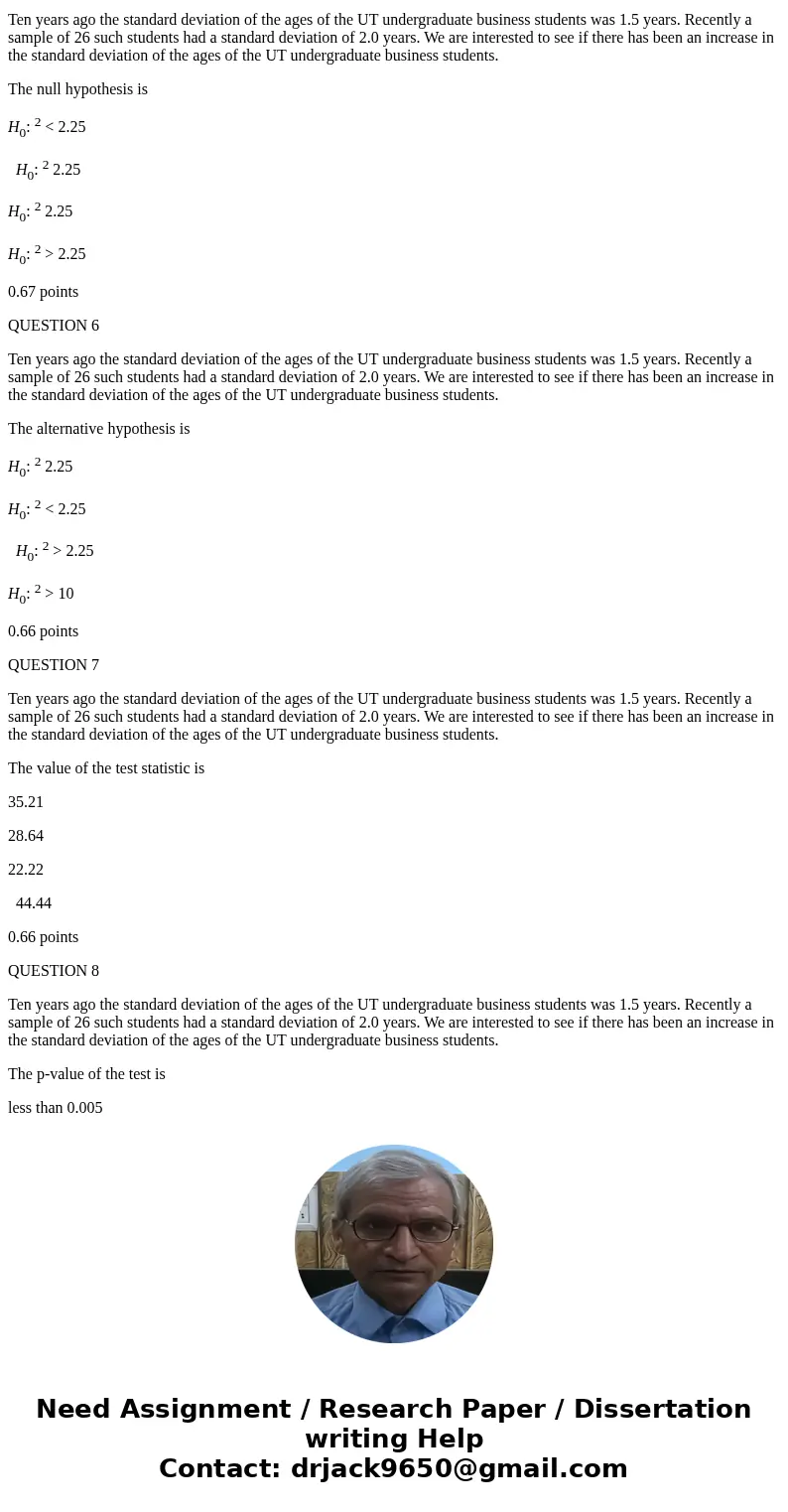
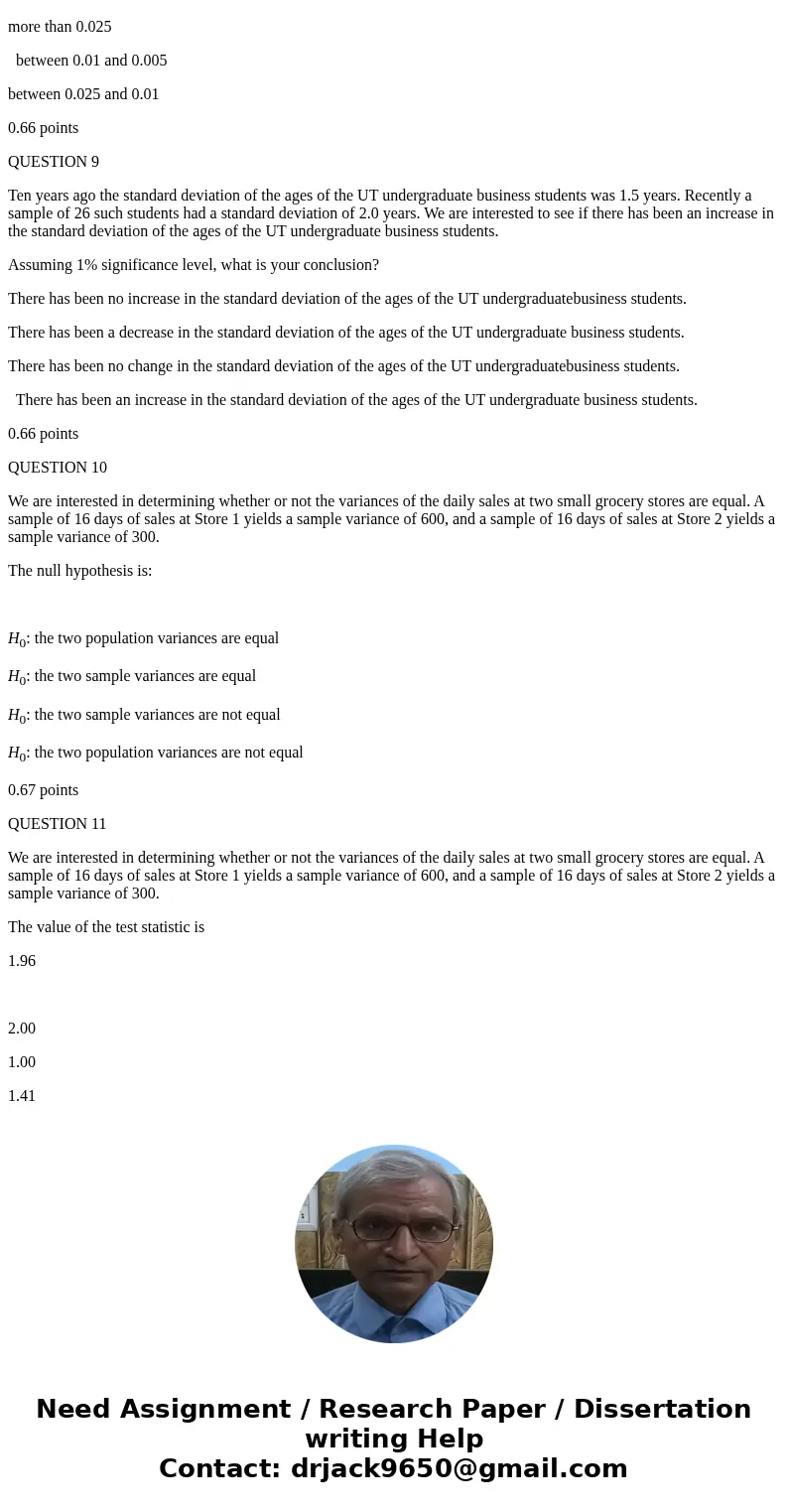
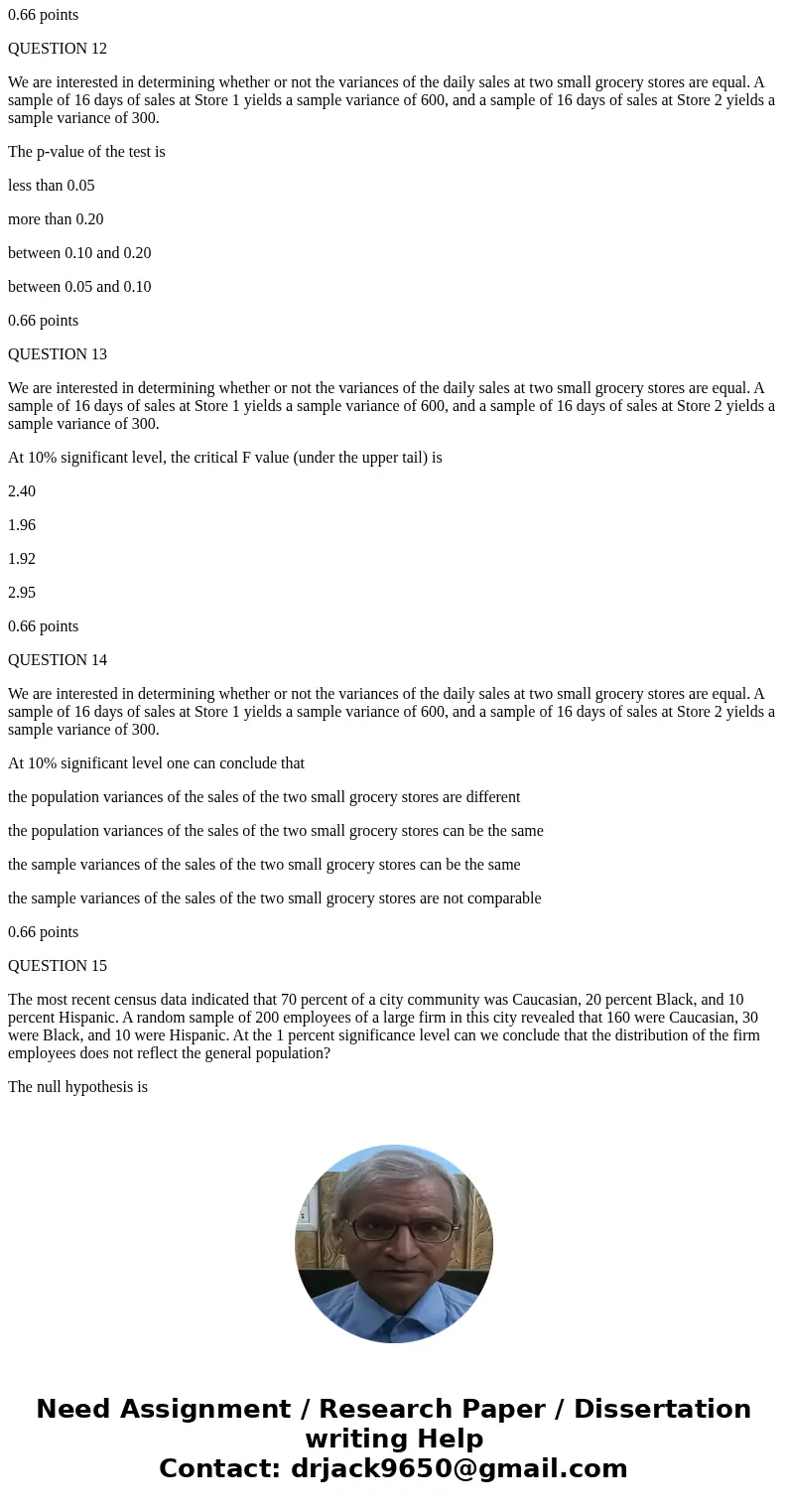
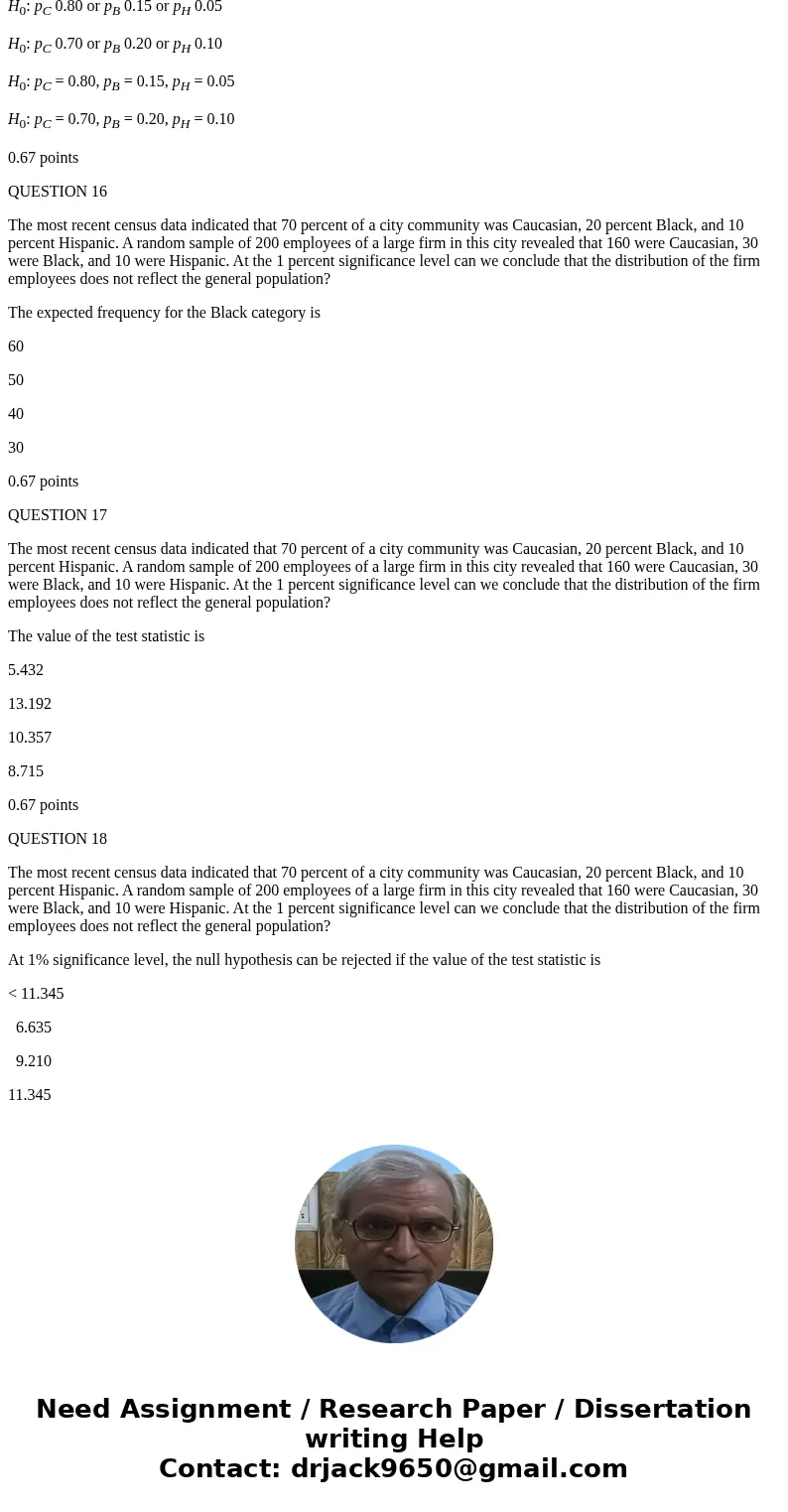
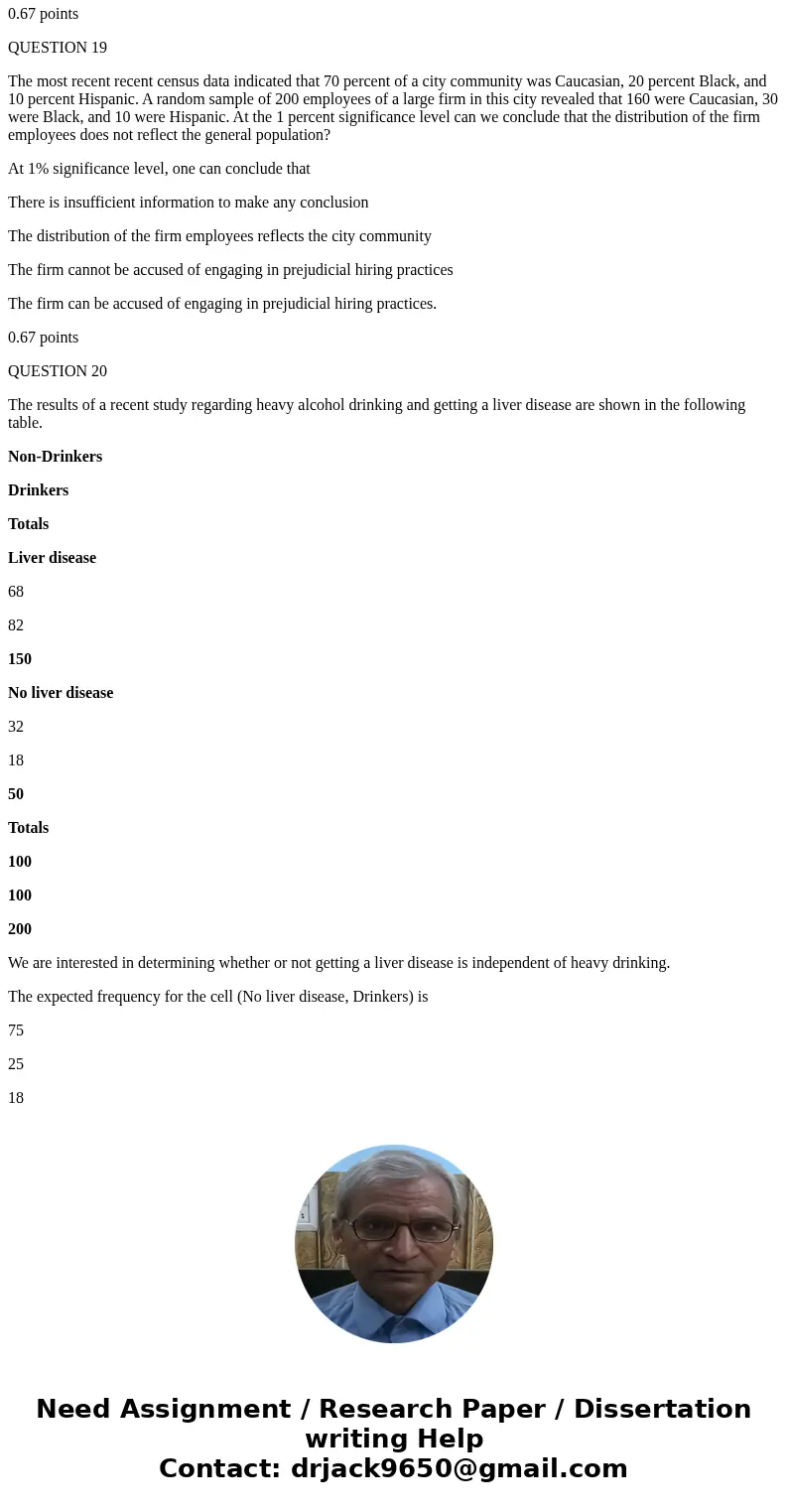
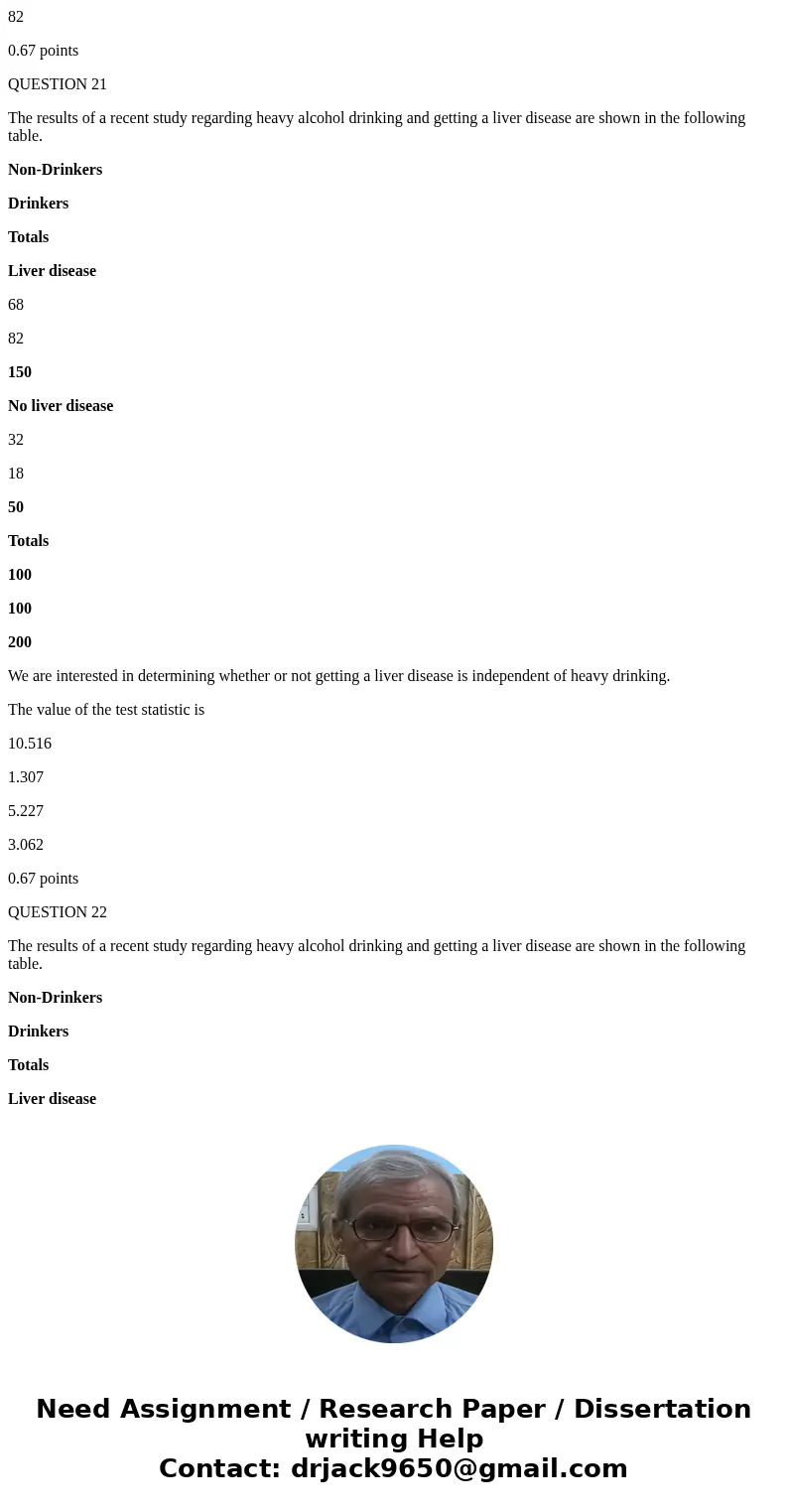
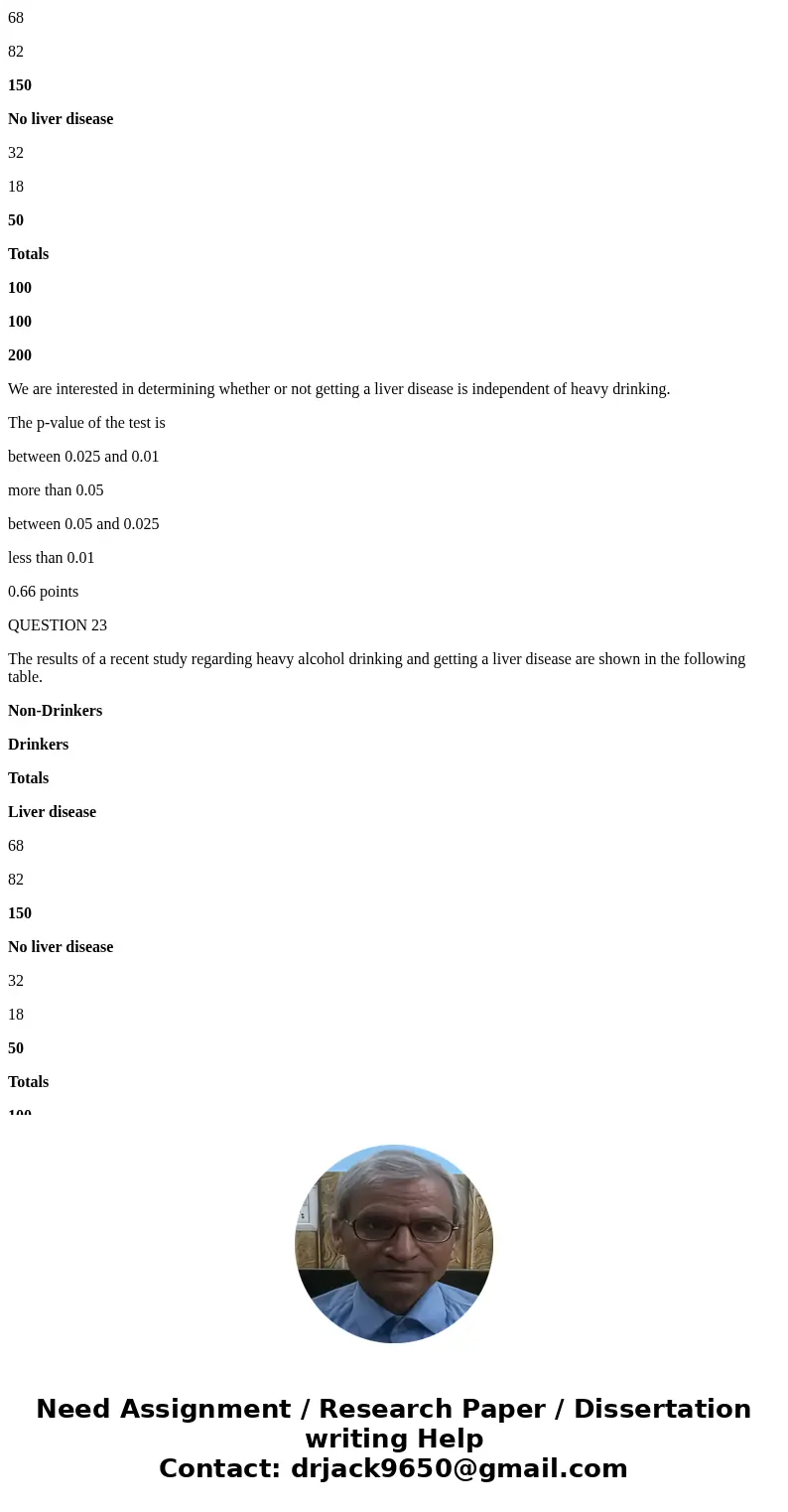
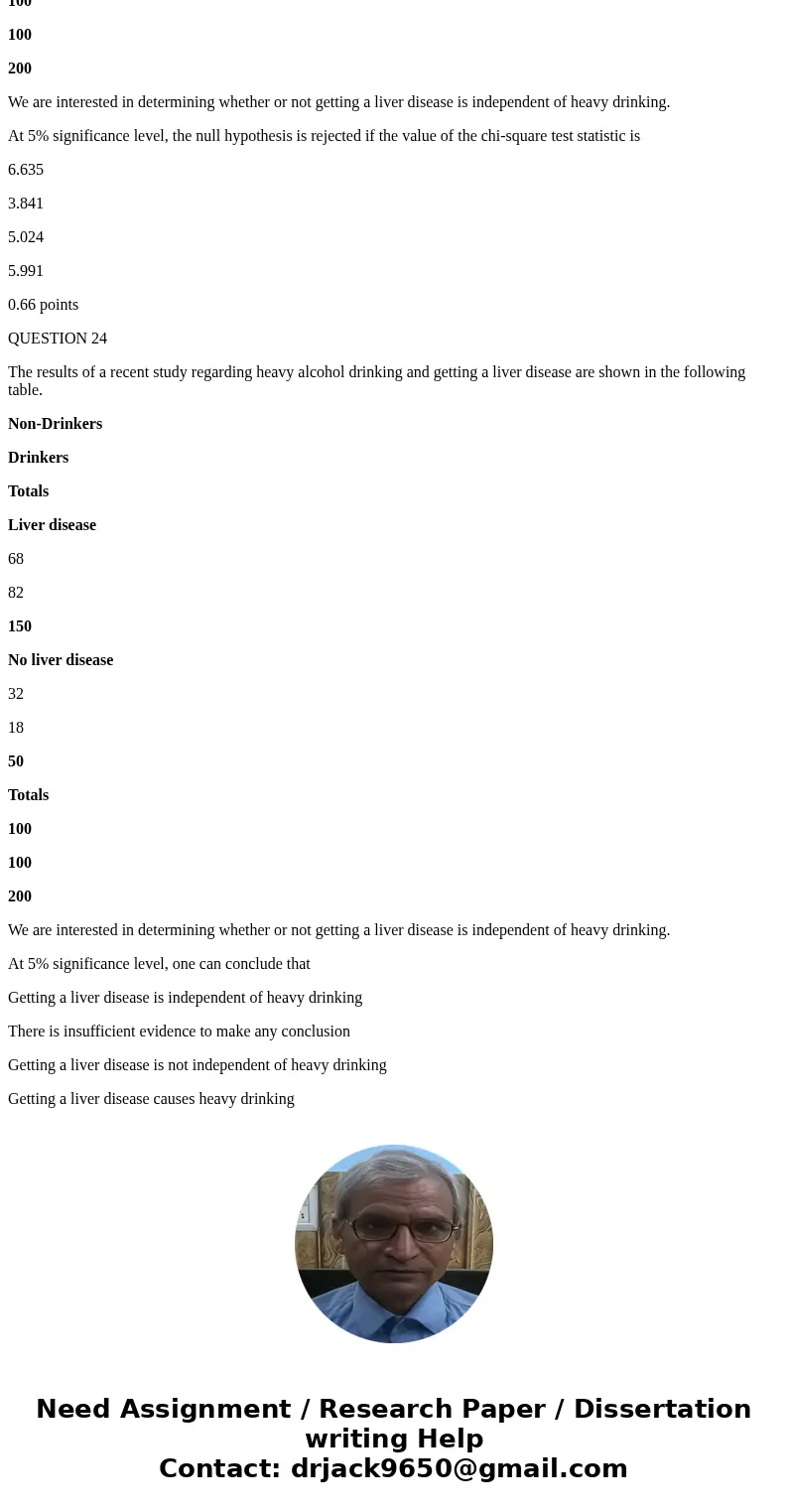
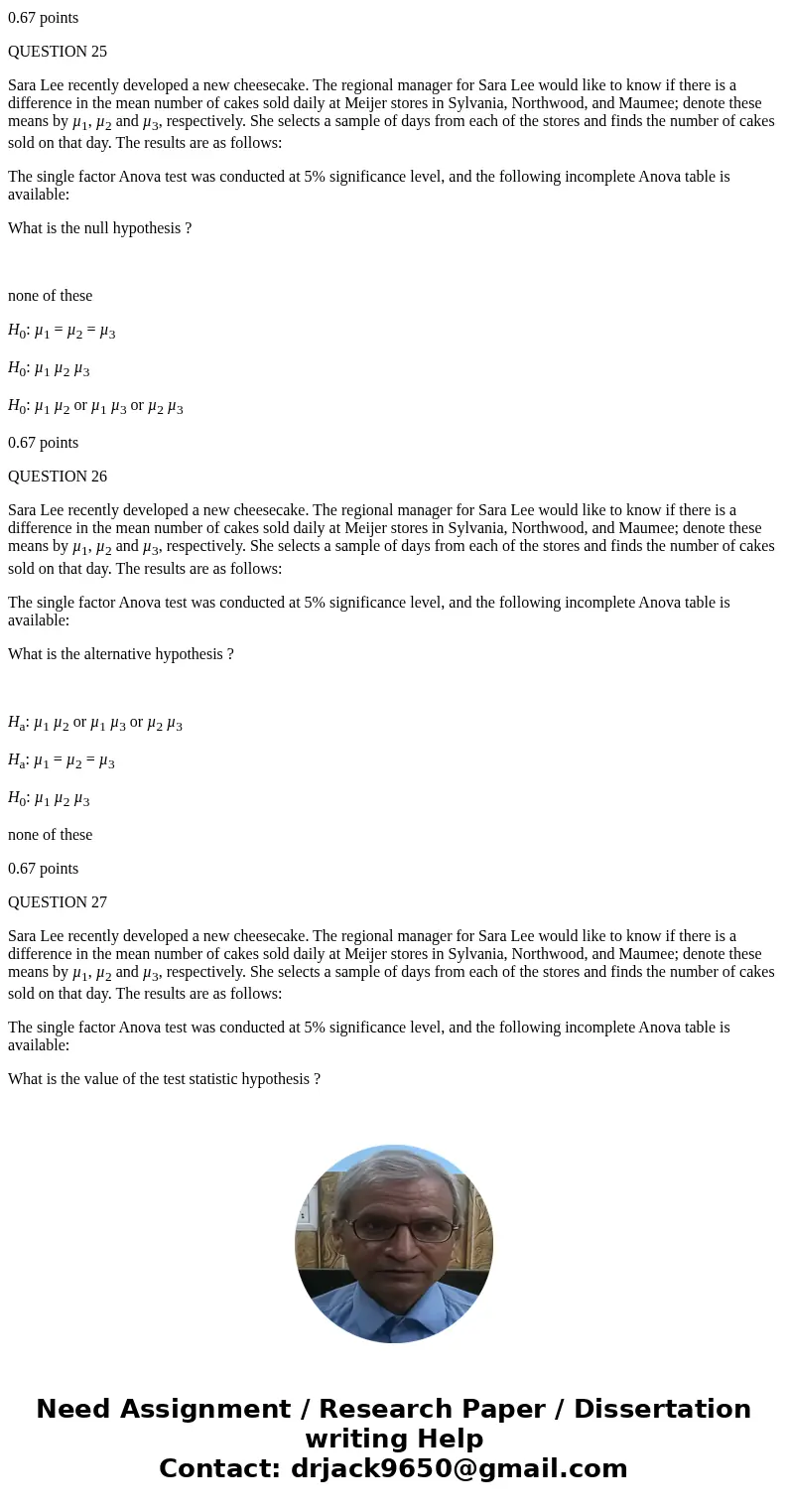
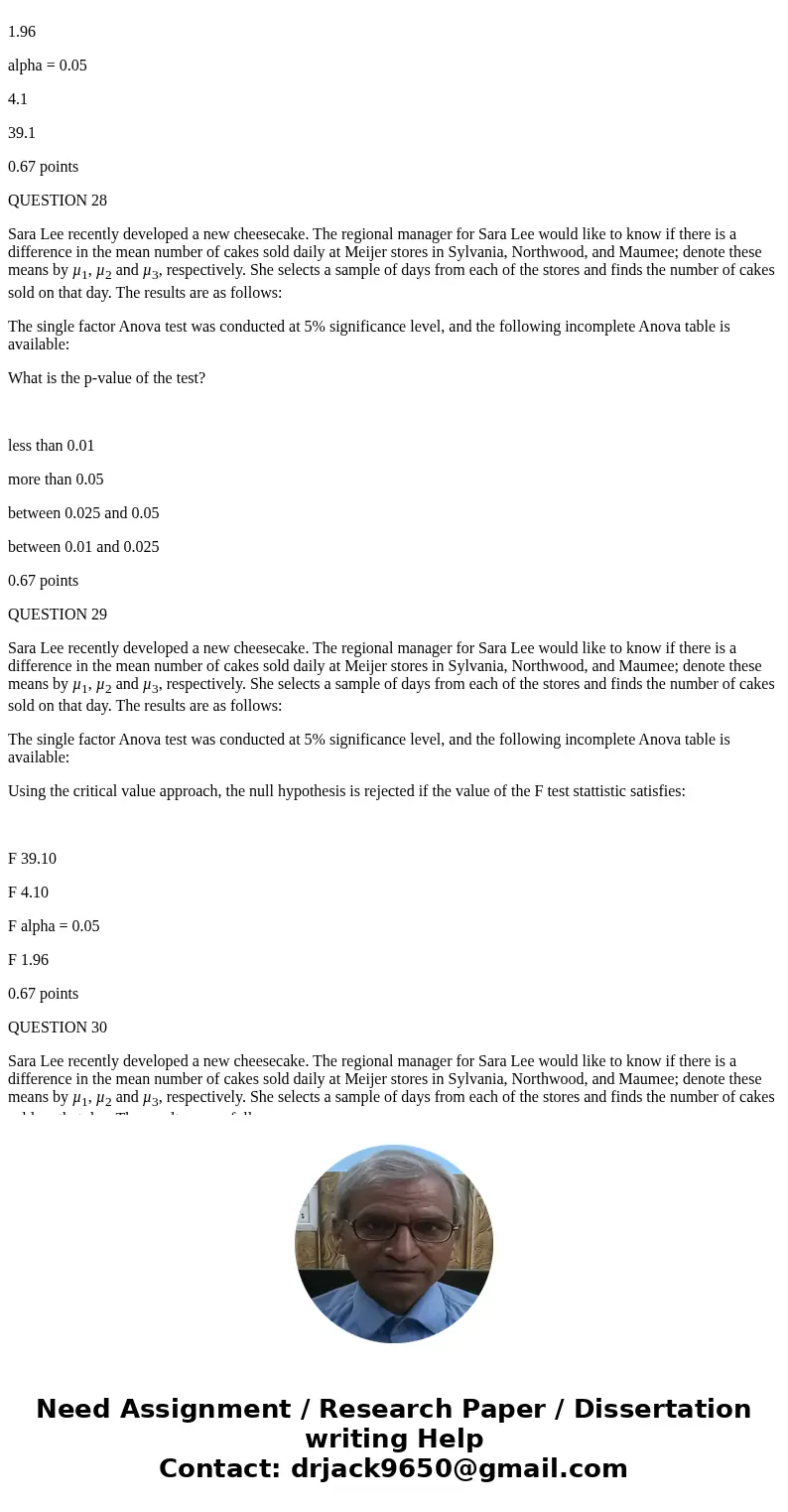
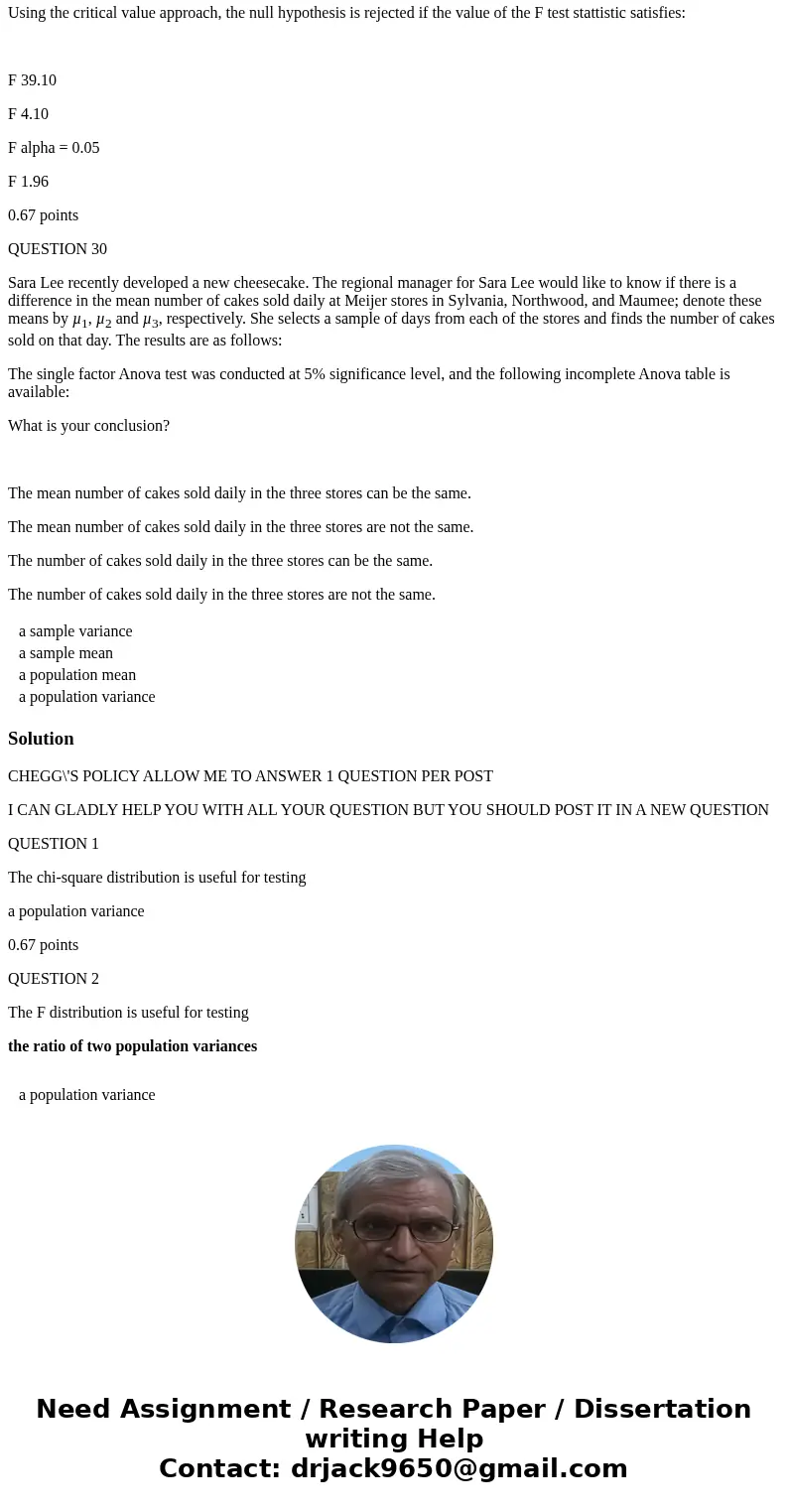
 Homework Sourse
Homework Sourse